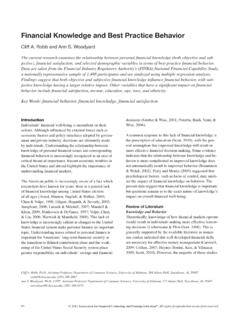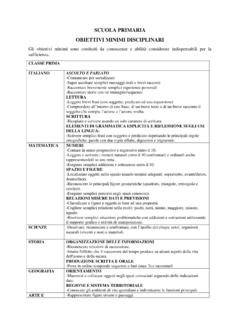Transcription of MEDIA USE BY TWEENS AND TEENS
1 THE COMMON SENSE CENSUS : MEDIA USE BY TWEENS AND TEENS2019 Suggested citation: Rideout, V., and Robb, M. B. (2019). The Common Sense census: MEDIA use by TWEENS and TEENS , 2019. San Francisco, CA: Common Sense Authors: Victoria Rideout, , VJR Consulting Michael B. Robb, , Common Sense Copy editor: Jenny Pritchett Designer: Dana K. HerrickCOMMON SENSE IS GRATEFUL FOR THE GENEROUS SUPPORT AND UNDERWRITING THAT FUNDED THIS RESEARCH REPORT:Eva and Bill PriceMargaret and Will HearstPrice Family Research FundCarnegie Corporation of New YorkCraig Newmark PhilanthropiesTHE COMMON SENSE CENSUS : MEDIA USE BY TWEENS AND TEENS2019 Introduction .. 1 Key Findings .. 3 Key Tables .. 11 Methodology .. 19 Screen MEDIA Use: Overview .. 23 MEDIA Devices: Access in the Home and Personal Ownership.
2 27 Television .. 29 Online Videos .. 33 Gaming .. 35 Social MEDIA and Texting .. 39 Emerging Technologies: Smart Speakers and Virtual Reality .. 41 Reading and Writing .. 43 Music .. 47 Content Creation .. 49 The Digital Divide .. 51 MEDIA and Homework .. 53 MEDIA Monitoring .. 55 Shopping Online .. 57 Conclusion .. 59 Appendix: Questionnaire .. 61 THE COMMON SENSE CENSUS: MEDIA USE BY TWEENS AND TEENS , 2019 1 THE COHMNSSNUH:DU:DHSDIABYHBWWH,A201:H,D:D,9 DIYTHIS REPORT PRESENTS THE results of a nationally represen-tative survey of more than 1,600 8- to 18-year-olds, about their use of and relationship with MEDIA . The survey covers their enjoyment of various types of MEDIA activities, how frequently they engage in those activities, and how much time they spend doing so.
3 The data are presented for two age groups: TWEENS (8- to 12-year-olds) and TEENS (13- to 18-year-olds). The survey addresses all types of MEDIA : from reading books in print and listening to the radio to using social MEDIA , watching online videos, and playing mobile games. And it covers young people s interactions with MEDIA technologies ranging from television sets and video game consoles to virtual reality headsets and smart speakers. The report also tracks changes in TWEENS and TEENS MEDIA behaviors between 2015 and 2019, comparing the current results to those found in the first wave of the survey, conducted four years ago. Each survey used a separate sample of respondents, with the text and format of the current questionnaire staying as close as possible to the previous one (allowing for some modest changes to reflect the changing MEDIA environment).
4 As far as we know, this is the only nationally representative survey tracking MEDIA use patterns among a truly random sample of 8- to 18-year-olds. Among the topics covered are: The degree to which TWEENS and TEENS enjoy using different types of MEDIA , from watching TV to listening to music and playing video games. How often they do each of these MEDIA activities: daily, weekly, monthly, or less. In any given day, how much time they spend engaging in various MEDIA activities, with screen or non-screen MEDIA . To what extent young people or their parents monitor the amount of time spent using screen MEDIA . How MEDIA usage varies by age, gender, race/ethnicity, household income, or parent education. Which MEDIA technologies young people own or have access to at home, and how that varies based on age or socioeconomic status.
5 To what degree young people use MEDIA technology to help with their homework, and which devices they use. The extent to which young people multitask with entertain-ment MEDIA while doing homework, and what impact they think that has on the quality of their work. The purpose of this survey is to present a big-picture look at the large trends and patterns of MEDIA usage among young people in the Obviously there is tremendous diversity in how individual children engage with technology or other MEDIA ; some are invet-erate readers and others online gamers. Some spend their time coding or making digital music, while others are devoted to their social MEDIA accounts or to watching the latest YouTube videos. What this study provides is the context in which to situate those disparate MEDIA -use patterns.
6 It helps us understand whether the girl who uses her online time to geek out or the boy who spends 10 hours of his day playing video games are the norms or the exceptions. Just as the Dow Jones Industrial Average offers a big-picture look at how the stock market is doing on average, this tracking survey offers a big-picture look at how young people, on average, are engaging with MEDIA . It tells us whether social MEDIA use is up or down, whether video games are more or less popular, and whether disparities in home computer access still exist. The goal is to provide reliable national data to help content creators, educators, policymakers, health providers, parents, and researchers understand the role of MEDIA in young people s lives, as they work to promote the health and well-being of TWEENS and THE COMMON SENSE CENSUS: MEDIA USE BY TWEENS AND TEENS , 2019 THE COHMNSSNUH:DU:DHSDIABYHBWWH,A201:H,D:D,9 DIYTHE COMMON SENSE CENSUS: MEDIA USE BY TWEENS AND TEENS , 2019 3 THE COHMNSSNUH:DU:DHSDIABYHBWWH,A201:H,D:D,9 DIYKEY FINDINGS1.
7 On average, 8- to 12-year-olds in this country use just under five hours worth of entertainment screen MEDIA per day (4:44), and TEENS use an average of just under seven and a half hours worth (7:22) not including time spent using screens for school or homework. Among TWEENS , the total amount of screen MEDIA used has stayed relatively steady over the past four years (an eight-minute increase from 4:36, not a statistically significant difference). Among TEENS , the amount of time devoted to several individual screen activities has ticked up slightly, leading to an overall difference of 42 minutes per day compared to 2015, when total screen use was 6:40 (this change is not statistically significant). Among teenagers, nearly two-thirds (62%) use more than four hours worth of screen MEDIA , including nearly three in 10 (29%) who use more than eight hours of screen MEDIA in a day (see Figure A).
8 Total average MEDIA time, including non-screen MEDIA activities such as reading books and listening to music, is 5:54 for TWEENS and 9:49 for Online video viewing is through the roof: More than twice as many young people watch videos every day than did in 2015, and the average time spent watching has roughly doubled. The biggest change in young people s MEDIA habits over the past four years isn t something brand new like virtual reality; it s the amount of time they spend watching online videos like those found on YouTube. The percent of young people who say they watch online videos every day has more than doubled among both age groups, going from 24% to 56% among 8- to 12-year-olds, and from 34% to 69% among 13- to 18-year-olds (see Figure B, page 4).
9 And the amount of time each age group spends watching online videos has gone from about a half hour a day to about an hour a day on average (from 25 to 56 minutes a day among TWEENS , and from 35 to 59 minutes a day among TEENS ). FIGURE A. Screen MEDIA : Percent who use for .. hours per day, by age, 2019 None 2 hours or less 2 4 hours* 4 8 hours More than 8 hoursTEENSTWEENS26%25%26%15%8%29%18%33%1 5%4%*Includes from 2:01 up to and including 4 hours. Includes from 4:01 up to and including 8 : Segments may not total 100% due to THE COMMON SENSE CENSUS: MEDIA USE BY TWEENS AND TEENS , 2019 THE COHMNSSNUH:DU:DHSDIABYHBWWH,A201:H,D:D,9 DIYFIGURE B. Online video viewing: Frequency and enjoyment, by age, 2015 vs. 2019 TWEENSW atch every day Enjoy a lot Watch every day Enjoy a lot 46%24%56%45%67%34%69%58% 2015 2019 2015 2019 TEENSFIGURE C.
10 Mode of television viewing among TEENS , 2015 vs. 20192019201548%33%*24%19%36%40%Percent of total viewing that occurs .. Live on a TV set Time-shifted on a TV set On other devices*Finding differs from what was published in the 2015 report, which inadvertently excluded on-demand clearly dominates the online video space among both TWEENS and TEENS . Despite the fact that YouTube says it is only for those age 13 or older, 76% of 8- to 12-year-olds say they use the site. By comparison, only 23% say they watch YouTube Kids. In fact, 53% of 8- to 12-year-olds say YouTube is the site they watch the most, compared to just 7% for YouTube Kids. Watching online videos has become so popular among TWEENS that it is now the MEDIA activity they enjoy the most, with 67% saying they enjoy it a lot ; four years ago, watching online videos was fifth in enjoyment among TWEENS , after TV, music, video games, and mobile games.






